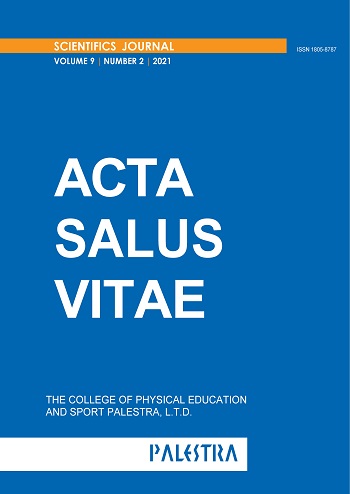Measurement of joint range of motion in sports practice
DOI:
https://doi.org/10.58743/asv2021vol9no2.273Keywords:
goniometry, joint range, sport, educational video programAbstract
Goniometry, measurement of the range of joint motion, is one of the basic diagnostic methods used in orthopedics, physiotherapy, or physical education and sports practice. However, we find differences in goniometric examinations and stated physiological range of motion of individual joints among the authors of professional publications. Based on the analysis of the professional literature, we selected the most frequently used data for the physiological range of joints, on which we can base the measurements. Our goal was to create a methodological material in the form of a video program with a methodical procedure and illustrative examples of measuring the angles of selected joints for the purpose of physical education and sports practice. It was realized within the project Internal Competition of the University of West Bohemia in Pilsen, in which students of the master program Physical Education Teacher participate. The creation of the video program was also initiated thanks to cooperation with the New Technologies – Research Center, University of West Bohemia in Pilsen, where we participate in research that deals with the development of personalized models of the human body. In the future, we would like to use the methodology to examine and compare the flexibility of athletes from different sports (also the flexibility of men and women, or different age categories - children, youth and adults).
References
Araújo C. G. (2008). Flexibility assessment: normative values for flexitest from 5 to 91 years of age. Arquivos brasileiros de cardiologia, 90(4), 257–263. https://doi.org/10.1590/s0066-782x2008000400008. English: https://pubmed.ncbi.nlm.nih.gov/18516386/
Bernaciková, M., Kalichová, M. & Beránková, L. (2010). Základy sportovní kineziologie: Pohyby v kloubech. Servisní středisko pro e-learning na MU. https://is.muni.cz/do/1451/e-learning/kineziologie/elportal/pages/pohyby_v_kloubech.html
Čihák, R. (2004). Anatomie. 2. vydání. Praha: Grada.
Haladová, E. & Nechvátalová, L. (2010). Vyšetřovací metody hybného systému. Brno: Národní centrum ošetřovatelství.
Janda, V. & Pavlů, D. (1993). Goniometrie. Učební text. Brno: Institut pro další vzdělávání pracovníků ve zdravotnictví.
Kolář, P. Rehabilitace v klinické praxi. (2020). Galén.
Norkin, C. C. & White, D. J. (2016). Measurement of joint motion: a guide to goniometry. Philadelphia: F.A. Davis.
Ostojic, S. & Stojanovic, M. (2007). Range of motion in the lower extremity elite vs non-elite soccer players. Serbian Journal of Sports Sciences 1(2), 74-78. https://www.sjss.sportsacademy.edu.rs/archive/details/full/range-of-motion-in-the-lower-extremity-elite-vs-non-elite-soccer-players-12.html
Podrigalo, L., Volodchenko, A., Rovnaya, O., & Stankiewicz, B. (2017). Analysis of martial arts athletes’ goniometric indicators. Physical Education of Students, 21(4), 182-188. https://doi.org/10.15561/20755279.2017.0406
Rychlíková, E. (2019). Funkční poruchy kloubů končetin: diagnostika a léčba. Grada.
Russe, O. A. & Gerhardt, J. J. (1975). International SFTR Method of Measuring and Recording Joint Motion. Huber.
Šíblová, H., Hlinecká, J. & Kačírková, K. (1995). Vyšetřovací metody hybného systému. Univerzita Karlova.
Yun, H., Lee, S. & Lee, D. (2002). A Study of Measurement on Range of Joint Mobility for Middle-Aged Korean Adults. Journal of the Ergonomics Society of Korea. 21(2). https://doi.org/10.5143/JESK.2002.21.2.035.
Downloads
Published
How to Cite
Issue
Section
License
Copyright (c) 2022 Gabriela Kavalířová

This work is licensed under a Creative Commons Attribution 4.0 International License.
Authors publishing in this journal agree to the following terms:
Authors retain copyright and grant the journal the right of first publication, while the work is also licensed under the Creative Commons Attribution License, which allows others to share this work acknowledging its author and initial publication in this journal.
Authors are permitted to enter into separate, additional contractual arrangements for the non-exclusive distribution of the work in the version published in the journal (for example, to publish it in a book), with an acknowledgement of its initial publication in this journal.
Authors are allowed and encouraged to share their work online (for example, on their websites) before and during the editorial process of their contribution, as such a practice can lead to productive exchanges of ideas and also earlier and higher citation of the published work (See the Open Access Effect).


